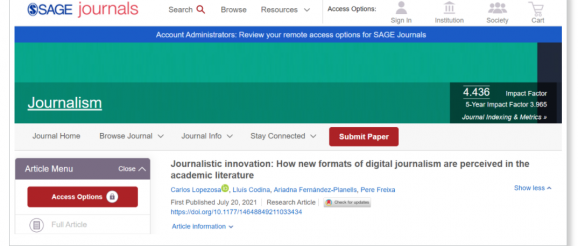Journalistic innovation: digital journalism in the academic literature

This article carries out a systematic review of the literature analysing the following
new journalistic formats: structured journalism, immersive journalism, 360° video
reports, virtual reality and augmented reality applied to journalism, newsgames and
docugames.
To do so, the scientific production examining these formats is first analysed to determine the academic impact of these studies, while identifying their characteristics and tracking their evolution over time.
Second, the leading researchers in this field are identified and interviewed to ascertain their opinion about the future of journalism and changing trends in journalistic formats. The results show that the number of academic publications about journalistic innovation peaked in 2019, above all in the three journals – Digital Journalism, Journalism Practice and Profesional de la Información – that lead the way in this discipline.
The 23 academics interviewed reported that innovation impacts primarily on four aspects of journalism: information and content; audience; methods and resources and news media companies.
360° videos, augmented reality, immersive journalism, journalistic innovation,
newsgames, structured journalism, systematic literature review, virtual reality
Journalistic genres are rapidly being transformed and, at the same time, the news media are exploring entirely new ways of telling and consuming news. To mention just two examples, some media outlets have begun publishing immersive reports, in which readers can take on the role of co-producers, while others are publishing news stories that transform themselves into cell phone video games, in which readers interact with the story as they advance through its various levels. Academic research has not turned a blind eye to these changes and there is already a highly significant corpus of work that examines the significance and scope of journalistic innovation from a range of different points of view.
However, because of the multifaceted nature of this innovation and because of the diversity of methodologies being employed, it is not easy to summarize the outcomes of research in this field. Here, in an attempt at rectifying this, we adopt a systematic approach to the review and analysis of academic studies of journalistic innovation.
The primary goal of this article is to identify the principal characteristics of academic
studies that examine innovations in digital journalism formats. We seek to achieve this
objective primarily by undertaking a systematic review of this corpus of academic literature (Booth et al., 2012; Hart, 2008). In addition, we set ourselves the following more specific goals:
(1) the determination of the parameters, dimensions and specific variables used in
the research methodologies and protocols of journalistic innovation studies;
(2) the identification of the structural characteristics of the research community that
publishes on this topic; and,
(3) evidence-based contributions to the debate concerning the definition of journalistic
innovation and the most significant characteristics of these new journalistic
formats.
To achieve these goals, we have adopted the framework of ‘Search, Appraisal, Synthesis, and Analysis’ or SALSA (Booth et al., 2012; Hart, 2008) in order, first, to locate and appraise and, second, to undertake a synthesis and analysis of academic studies of the following innovative formats: structured journalism, immersive journalism, which includes both virtual and augmented reality and 360° video reports, newsgames and docugames. Finally, in order to triangulate this evidence, interviews were conducted with a panel of experts, considering as such, for the purposes of this research, the authors previously identified in the literature review.

